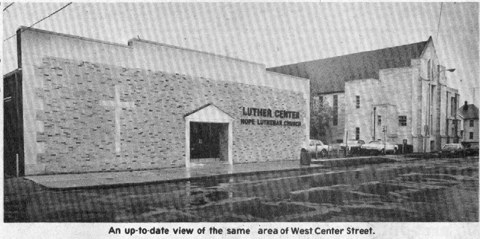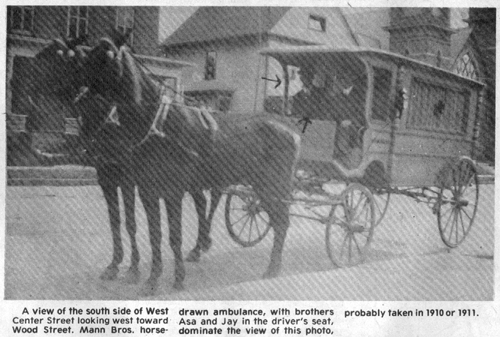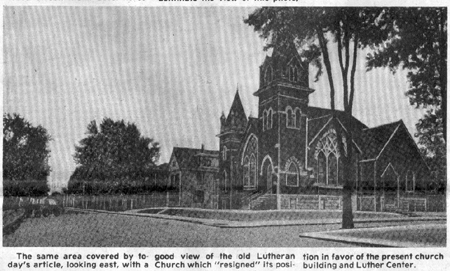December 9, 1982



Picture #1 – An up-to-date view of the same area of West Center Street.
Picture #2 – A view of the south side of West Center Street looking west toward Wood Street. Mann Bros. horse-drawn ambulance, with brothers Asa and Jay in the driver’s seat, dominate the view of this photo probably taken in 1910 or 1911.
Picture #3 – The same area covered by today’s article, looking east, with a good view of the old Lutheran Church which “resigned” its position in favor of the present church building and Luther Center.
The last installment of the West Center Street story was Oct. 14, and I promised to continue at a later date. The series continues today with the description of the south side of the street, west of the mid-block, north- south alley.
Unfortunately, a photo showing all of the buildings in that half block area seems not to exist. The only one available, provided by John Mann, shows Mann Bros. horse-drawn ambulance in the foreground and all but one of the buildings. Readers will recall, according to the fourth installment in the series Mann Bros. Undertaking establishment was located in the Burtscher Block at No. 115.
The current photo of that same area is with today’s article and shows the Luther Center on the left. The Luther Center was remodeled from a structure which Dr. A.J. Reycraft built in about 1927, where several small frame buildings stood previously.
OCCUPANTS OF REYCRAFT BUILDING
If my research is correct, the first to occupy the Reycraft building was Dillon Auto Sales with Don Dillon, proprietor. He sold the Peerless cars, made in Cleveland, using continental motors. There were two models, large and small. Pius Bloom Town Street, a car mechanic for many years, reminded me that he had one of the large models, driving it for 190,000 miles. I had one of the small models. Back then cars had heavy gauge metal on the bodies which provided long life to match that of the motors.
Bloom believes it was in 1930 when he and Ernest Dillon, brother of Don, took over the service work for the Peerless cars and also did general service work on other cars.
Later, Don Dillon quit selling cars and devoted full time to his machine shop, and then Coppus Motor Sales sold cars at that location.
Dr. Reycraft had an office in the northwest corner of his building starting in 1932 where he continued his practice of medicine until his retirement.
When the First National Bank building at Main and Center was torn down in 1947, Dr. A.O. Cole who had offices there then moved to Reycraft’s office.
In 1936, W.E. Kinney established the Chrysler-Plymouth agency in the Reycraft building and continued there until 1938. At that time he moved his agency to West North Street and A&P Supermarket established a store there, remaining until 1965 when they moved to North Countyline Street where they were until going out of business in Fostoria. That’s where Lane Drug Store is now.
In 1965, Sears took over the Reycraft building and remained there until 1978. Walter A. Roth became owner of the building in the early 1960’s and it was he who sold it to the Lutheran Church for their center.
TWO PHOTOS PROVIDE PERSPECTIVE
Refer to the photo showing the Luther Center. Imagine for a moment that there is nothing occupying the land from the west end of that building to the corner, no church parking lot or church. Now, refer to the photo with the horse-drawn ambulance and the three structures in the background, pick up those three buildings – the brick house, the church parsonage, and the old Lutheran Church – it would be possible to place them in that area.
The brick house in the old photo, which was No. 137, was inhabited by Russell J. Smith, barber for many years. Others known to have lived there were: Mrs. Arcena E. Henry, George E. Imber, E.E. Dres, Mrs. M. Merritt, George Lamson, John Murphy, Charles J. Mills, Mrs. Hattie Hazen, Esther E. Steyer, Harry K. Swartz, Mrs. Minnie Prante, Donald D. McDowell, Mrs. Ruth Segner, and The Dependable Mortgage Co., also had offices there.
The Lutheran parsonage (No. 139) was occupied by the Rev. George Dillman from 1904-1916, and the Rev. C.E. Clessler, from 1916-1944, when he retired due to ill health. The Rev. Victor Scheiber resided in the old parsonage for a short time after he replaced Clessler. (See complete story about Hope Lutheran Church history in Potluck articles July 23 and Aug. 6, 1981)
GOOD VIEW OF OLD CHURCH
The last photo reference is another view of the same area taken many years ago, showing the old Lutheran Church, typical of churches constructed in Fostoria in earlier days.
Your author is almost certain that Center and Wood streets were paved with brick at that time. There is a personal recollection I must tell, inasmuch as it partly related to the old church photo.
The time was either 1922 or 1923. It was the time of year when the northern lights (aurora borealis) were at their best. A brilliant display of vari- colored lights which at times seemed to come to a peak directly above the above the main spire of the church (in the foreground of photo).
I was one of a group of high school boys who spent time at the “Y” and who watched the heavenly display that night. Why did the lights seem to be in league with the church that night? What did it mean? Many questions about the phenomena raced through my mind and perhaps the others too that night.
Never had I seen such an unusual or brilliant display of the northern lights before, or since.